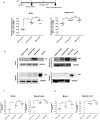A new animal model containing human SCARB2 and lacking stat-1 is highly susceptible to EV71
- PMID: 27499235
- PMCID: PMC4976353
- DOI: 10.1038/srep31151
A new animal model containing human SCARB2 and lacking stat-1 is highly susceptible to EV71
Abstract
Enterovirus 71 (EV71) is a major threat to children worldwide. Children infected with EV71 could develop subclinical infection and hand-foot-and -mouth disease (HFMD). In severe cases, patients could develop encephalitis, paralysis, pulmonary edema, and death. A more user-friendly and robust animal model is essential to investigating EV71 pathogenesis. Here, we established a hybrid (hSCARB2(+/+)/stat-1(-/-)) mouse strain from crossbreeding SCARB2 transgenic and stat-1 KO mice, and compared the susceptibilities to EV71 infection and pathogenesis between parental and hybrid mice. Virus-encoded VP1 protein can be detected in the streaking nerve fibers in brain and spinal cord. This hybrid mouse strain at 2-week-old age can still be infected with different genotypes of EV71 at 1000-fold lower titer via an ip route. Infected hybrid mice developed earlier onset of CNS disease, paralysis, and death at a higher incidence. These advantages of this novel model meet the urgent need from the scientific community in basic and preclinical research in therapeutics and pathogenesis.
Figures





References
Publication types
MeSH terms
Substances
LinkOut - more resources
Full Text Sources
Other Literature Sources
Molecular Biology Databases
Research Materials
Miscellaneous

